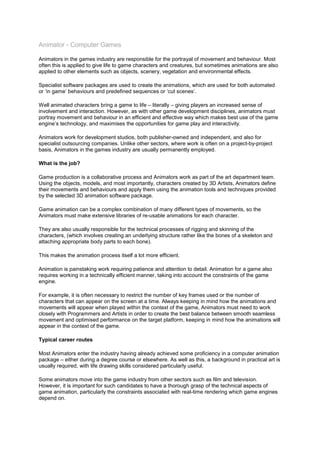
Additional research
- 1. Animator - Computer Games Animators in the games industry are responsible for the portrayal of movement and behaviour. Most often this is applied to give life to game characters and creatures, but sometimes animations are also applied to other elements such as objects, scenery, vegetation and environmental effects. Specialist software packages are used to create the animations, which are used for both automated or ‘in game’ behaviours and predefined sequences or ‘cut scenes’. Well animated characters bring a game to life – literally – giving players an increased sense of involvement and interaction. However, as with other game development disciplines, animators must portray movement and behaviour in an efficient and effective way which makes best use of the game engine’s technology, and maximises the opportunities for game play and interactivity. Animators work for development studios, both publisher-owned and independent, and also for specialist outsourcing companies. Unlike other sectors, where work is often on a project-by-project basis, Animators in the games industry are usually permanently employed. What is the job? Game production is a collaborative process and Animators work as part of the art department team. Using the objects, models, and most importantly, characters created by 3D Artists, Animators define their movements and behaviours and apply them using the animation tools and techniques provided by the selected 3D animation software package. Game animation can be a complex combination of many different types of movements, so the Animators must make extensive libraries of re-usable animations for each character. They are also usually responsible for the technical processes of rigging and skinning of the characters, (which involves creating an underlying structure rather like the bones of a skeleton and attaching appropriate body parts to each bone). This makes the animation process itself a lot more efficient. Animation is painstaking work requiring patience and attention to detail. Animation for a game also requires working in a technically efficient manner, taking into account the constraints of the game engine. For example, it is often necessary to restrict the number of key frames used or the number of characters that can appear on the screen at a time. Always keeping in mind how the animations and movements will appear when played within the context of the game, Animators must need to work closely with Programmers and Artists in order to create the best balance between smooth seamless movement and optimised performance on the target platform, keeping in mind how the animations will appear in the context of the game. Typical career routes Most Animators enter the industry having already achieved some proficiency in a computer animation package – either during a degree course or elsewhere. As well as this, a background in practical art is usually required, with life drawing skills considered particularly useful. Some animators move into the game industry from other sectors such as film and television. However, it is important for such candidates to have a thorough grasp of the technical aspects of game animation, particularly the constraints associated with real-time rendering which game engines depend on.
- 2. Any animator considering a career in game production should understand the interactive nature of games and also have an overall grasp of all aspects of their discipline, including character modelling, rigging, skinning, kinematics, and basic cinematography. They will also have to demonstrate proficiency in at least one animation package, such as 3D Studio Max, Character Studio or Maya. Essential knowledge and skills Animators must be able to work as part a team and also on their own initiative, taking responsibility for organising their work within the production schedule, managing files and meeting deadlines. An understanding of the production process and the ability to communicate effectively with other disciplines is essential. Some knowledge of programming is desirable. Game animation must be simple and expressive. The Animator should know how to reveal attitude, emotions and mood through a character’s movement and behaviour, creating memorable characters that will appeal to players. Knowledge of the timing and appearance of human and animal movement and facial expressions is essential. The ability to lip sync is also important. Animation for games requires a combination of art, technical and organisational skills, including: knowledge of traditional and computer 2D and 3D animation techniques; creativity and imagination; knowledge of full motion video (FMV); spatial awareness and a feel for movement over time; knowledge of constraints; ability to work independently and as part of a team; organisational skills and the ability to work to deadlines; good communication and presentation skills; knowledge of the requirements of the relevant Health and Safety legislation and procedures. Training and qualifications An animation-related degree is usually a prerequisite. This might be a general art course with a computer animation component, or a specialist animation course. Animation degrees and courses are available at a wide range of institutions across the UK – it is important to check the content before embarking on what can be a lengthy period of training. An increasing number of institutions offer specialist computer animation training, eg the National Centre for Computer Animation in Bournemouth. Some courses also offer work experience placements. Animators will be required to demonstrate their work through a portfolio and/or show reel. Reels should last about 2-3 minutes and detail the specific contribution the Animator made to the work. Recruiters look for a variety of genres and styles; walk and run cycles, as well as more fully developed sequences; and, perhaps most important, an ability to portray a character’s personality through movement and behaviour.